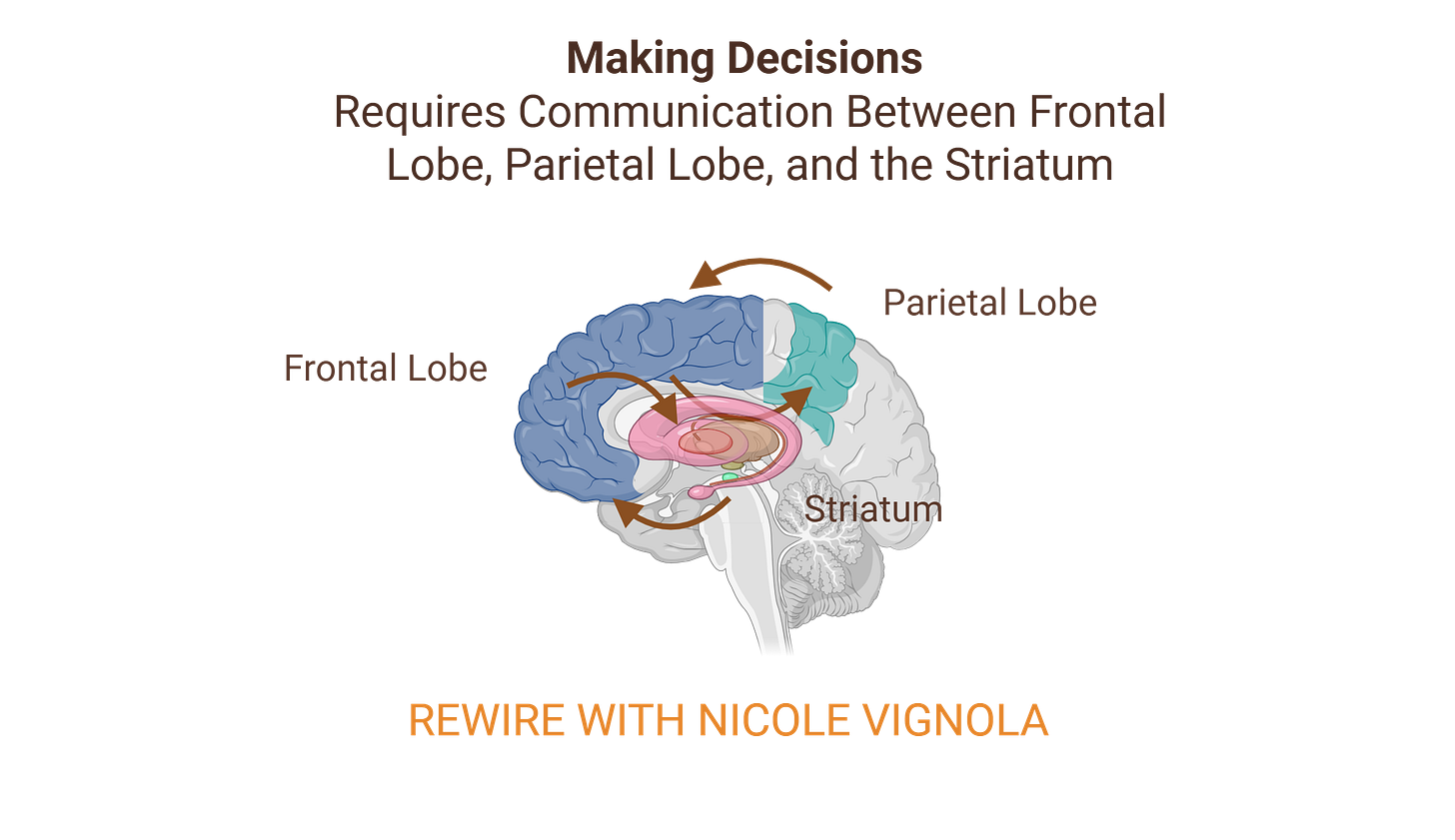Hey Rewire Collective!
Welcome to this week’s newsletter! We’ll be be doing a deep dive into decision paralysis and decision fatigue.
And if you haven’t checked out my book yet, I cover this plus more, helping you to break the cycle and create lasting change!
Decision-Making

I’ve briefly touched on decision-making and indecision in previous newsletters, but we need to all be on the same page about how decision-making works. Let’s get into it:
The link between the ventromedial prefrontal cortex and the striatum (1) is crucial for decision-making.
Together, these two regions help our brain conceptualise the value of goods and actions.
They respond to rewards in a way that imitates tracking and forecasting the value of rewards.
They also account for the time taken to receive a reward.
Dopamine is involved in this process by giving value to rewards, monitoring if the reward was expected, and tracking which behaviours cause which rewards (1).
The parietal cortex, which I’ve mentioned previously, works with the lateral prefrontal cortex to stop mulling over options and actually make the decision (2).
Decision Paralysis (3)
If we think about where this could go wrong, all regions and circuits are susceptible to issues.
The ventromedial prefrontal cortex and striatum may struggle to create a value for the reward derived from each action. How can you decide if you don’t know which action is ‘the best’?
Or perhaps, the value of an action is continually changing and being updated. This can lead to a lot of energy being spent on simple decisions, and feeling like it’s impossible to decide (common in ADHD and perfectionism).
Or perhaps, the parietal lobe isn’t firing appropriately, and the decision-making process is never stopped.
Let’s take a look at different ways decision paralysis can occur:
Executive Dysfunction
Executive dysfunction is common within other disorders, like autism and ADHD, whereby tasks involving planning, organising, decision-making, task switching, time management, emotional regulation, and memory/attention are disrupted (4).
The prefrontal cortex is heavily involved in the actions described above, and so any changes in the prefrontal cortex can lead to executive dysfunction (5). Generally, changes in dopamine and serotonin are responsible for the disruption in the prefrontal cortex. These changes in neurotransmitters make it difficult to filter out irrelevant information and compare the pros and cons of each action.
Fronto-striatal dysfunction
Fronto-striatal dysfunction, or the inappropriate communication between the frontal lobe and striatum (6) is common in ADHD and other disorders where we see decision paralysis. In fact, the volume of these regions is smaller in people with these disorders (7,8). The inability to define the value of an action and reward, and decide which one is better, generally occurs when the frontal lobe and striatum aren’t communicating well.
Emotional Dysregulation
Struggling to regulate emotions can make decision-making inappropriate and more difficult. Emotional dysregulation typically results from the frontal lobe failing to exert cognitive control over the striatum (6), which means we are more likely to make risky choices that aren’t in line with our goals (9).
It also means we’re more likely to overthink, ruminate, and sit in feelings of anxiety. And feeling anxious is only going to make decision-making harder (10), because it allows us to continue coming up with different values for different actions, aka creating all those “what if?” scenarios that are not so helpful (11).
Paradox of Choice
The Paradox of Choice is a book written by psychologist Barry Schwartz which delves into the psychology behind having too much choice. Although autonomy and freedom of choice are central to our well-being, too much choice has the opposite effect, leaving us overwhelmed, stressed, and dissatisfied (12).
And part of this certainly has to do with decision fatigue.
Decision Fatigue is the concept that the more decisions we make throughout the day, the more fatigued our brains get, and the worse the decisions we make (13). This has been best studied in nurses (14,15), but it isn’t just nurses who report symptoms of decision fatigue:
32% of adults are overwhelmed by daily decisions, like what to eat or wear (16).
70% of business leaders would prefer a robot to make decisions for them (17).
And ultimately, once decision fatigue sets in and we become overly stressed, our decisions either become riskier or non-existent.
What To Do?
Reduce the number of choices you need to make
Remember how Steve Jobs always wore the same outfit? (18)
Have a routine and structure to your day to minimise decisions.
Set a time limit to make the decision
Create Checklists and Planners
To keep organised and remove the mental burden of keeping your to-do list in your brain
Prioritise tasks
Limits decision making and decision fatigue– you know what to do first based on importance
Practice
Practice making quick decision with things that are less important.
Following a decision-making framework may be a good way to get you started
Change your perspective–
if you’re worried about making a mistake, try repeating to yourself that the mistake doesn’t define you, it’s a learning experience, and it’s okay to make mistakes.
Identify when you have all the information you possibly can.
A big part of decision paralysis is waiting for/wanting more information to appear to help make the choice. But life is uncertain, and we sometimes can’t have all the necessary information. That’s okay.
Until Next Week,
Nicole x
P.S. Leave requests for future newsletters in the comments!
References
1. https://pmc.ncbi.nlm.nih.gov/articles/PMC2765926/
2. https://www.nature.com/articles/ncomms9090
4. https://www.healthline.com/health/executive-dysfunction
5.https://www.frontiersin.org/journals/neuroscience/articles/10.3389/fnins.2017.00431/full
6. https://pmc.ncbi.nlm.nih.gov/articles/PMC7231228/
7. https://www.sciencedirect.com/science/article/pii/S2213158220302400
8. https://www.nature.com/articles/npjschz20151



Can you talk about dissociation?
Can you talk about dissociation?